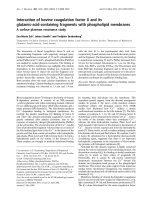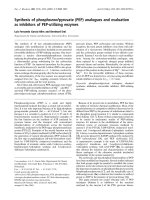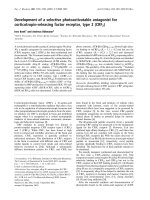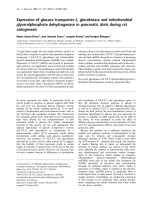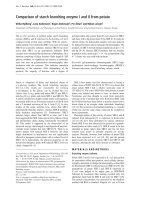Báo cáo y học: "Kinetics of non-structural protein 1, IgM and IgG antibodies in dengue type 1 primary infection" pps
Bạn đang xem bản rút gọn của tài liệu. Xem và tải ngay bản đầy đủ của tài liệu tại đây (275.39 KB, 4 trang )
RESEARC H Open Access
Kinetics of non-structural protein 1, IgM and IgG
antibodies in dengue type 1 primary infection
Dongmei Hu
1
, Biao Di
2
, Xixia Ding
1
, Yadi Wang
1
, Yue Chen
1
, Yuxian Pan
1
, Kun Wen
1
, Ming Wang
2
, Xiaoyan Che
1*
Abstract
Background: Early and accurate diagnosis of dengue infection is essential for control of disease outbreaks.
Recently, the dengue virus non-structural antigen 1 (NS1), a conserved and secreted glycoprotein, has been used
as a marker for early diagnosis of dengue with convenience and cost-effectiveness. Serological tests of dengue IgM
and IgG antibodies are still the most widely used for diagnosis of dengue. In order to assess combined diagnostic
value of these tests, we study the kinetic profiles of circulating NS1, dengue IgM and IgG antibodies over the
course of the disease by using an in-house dengue type 1 (DENV1) specific NS1 capture ELISA and the commercial
Panbio Dengue IgM and IgG capture ELISAs.
Results: A panel of 313 acute-and early convalescent-phase serum specimens from 140 DENV1 primary infected
patients during an outbreak of dengue in Guangzhou, China, in 2006 were studied. Dengue NS1 presented high
levels in acute-phase serum samples. It was detectable as early as day 1 of illness, and up to 14 day after onset.
The sensitivity of NS1 detection was ranged from 81.8% to 91.1% with samples taken during the first 7 days. Anti-
dengue IgM antibody was detectable on the third day of onset with the positive rate of 42.9%, and rapidly
increasing to 100% by day 8 of illness. Anti-dengue IgG antibody was detectable on the fifth day of onset with low
level at the first week of onset, and slowly increasing to 100% by day 15 of illness. Combining the results of NS1
and IgM antibody detection allowed positive diagnosis in 96.9% -100% for samples taken after day 3 of onset.
Conclusions: Dengue NS1 detection might shorten the window period by first few days of illness. A combination
of dengue NS1 antigen and IgM antibody testing facilitates enhanced diagnosis rates. The procedures should be
suitable for developing countries where dengue is endemic.
Background
Dengue is a major public health concern globally [1].
The incidence rate of the disease increased rapidly dur-
ing the last decades. Dengue virus (DENV) consists of
four distinct serotypes (DENV1 to 4). Infection with any
one of the serotypes can cause a broad spectrum of
manifestations from asymptomatic or mild dengue fever
(DF) to dengue hemorrhagic fever (DHF) or dengue
shock syndrome (DSS). As no protective vaccine or spe-
cific treatments are available for dengue, earl y and accu-
rate laboratory diagnosis is essential for the effective
surveillance and control of disease outbreaks. Currently,
dengue diagnostic methods are based on virus isolation,
RNA and antigen de tection, and serology [2,3]. Viral
RNA detection assays provideahighlysensitiveand
rapid diagnosis in the acute phase, but this approach
requires specialized laboratory equipments and experi-
enced technicians which are limitations in many devel-
oping countries where dengue is endemic [4]. IgM
antibody capture enzyme-linked immunosorbent assay
(MAC-ELISA) is the most commonly used technique
for routine diagnosis. The dengue serological assays
however become more challenging because dengue anti-
bodies are cross re active with other flaviviruses such a s
WestNilevirus(WNV),St.Louisencephalitisvirus
(SLE), Japanese encephalitis virus (JEV), and yellow fever
virus (YFV). In addition, IgM antibody response varies
considerably among the individuals due to host humoral
immune response or depending on whether a primary
vs a secondary infection [2,4]. More recently, dengue
virus non-structural protein 1 (NS1) antigen capture
ELISAs have been reported as being a promising tool
* Correspondence:
1
Center for Clinical Laboratory, Zhujiang Hospital, Southern Medical
University, Guangzhou, PR China
Full list of author information is available at the end of the article
Hu et al. Virology Journal 2011, 8:47
/>© 2011 Hu et al; lice nsee BioMed Central Ltd. This is an Open Access article distributed under the terms of the Creative Commons
Attribution License ( which permits unrestricted use, distribution, and reproduct ion in
any medium, provided the original work is properly cited.
for the diagnosis of acute dengue infection s [5-12]. NS1
antigen assay has many advantages over RT-PCR assays
including rapidity, convenience and cost-effectiveness.
Circulating NS1 has been shown to be detectable from
the first day to the early conva lescent phase after onset
of disease. Monoclonal antibody (MAb)-based serot ype-
specific NS1 assays can be used to di fferen tiate between
flaviviruses [8,10].
ELISA-based detection of viral antigens and specific
antibodies have the advantage of being easier to perform
and standardize, specially being suitable for resource
poor countries. Consequently, these procedures are
likely to become routine methods for diagnosing dengue
infection. An understanding of the kinetic profiles of
dengue NS1, as well as dengue IgM and IgG antibody
responses will help clarify the advantages and disadvan-
tages of these tests for diagnosing dengue infection. In
this study, we used a well-characterized pane l of acute
and early convalescent-phase serum specimens collected
from dengue patients during DENV1 outbreak in
Guangzhou, China, in 2006 to study the kinetic profiles
of circulating NS1, dengue IgM, and IgG antibody
responses over the course of the disease. The aim of the
present study was to evaluate combined diagnostic value
of these tests.
Materials and methods
Clinical samples
A panel of 313 acute- and convalescent-phase serum
specimens were collected between days 1 and 27 after
the onset of symptoms from 140 infected patients dur-
ing the disease outbreak in Guangzhou, Guangdong pro-
vince, China, in 2006 [13,14]. All these patients had
been laboratory-confirmed previously as being infected
with DENV1 by virus isolation and/or viral RNA detec-
tion by RT-PCR and/or serological diagnosis by MAC-
ELISA. Of these 140 patients, 109 patients provided two
serum samples; 29 patients had three serum samples,
and 2 patients had four serum samples. All the patients
were classified as having dengue fever; no patient had
the severe manifestations of d engue hemorrhagic fever
or dengue shock syndrome, according to the World
Health Organization criteria [15]. Disease day 1 was
designated as the day of the onset of symptoms. Five
hundred and thirty-seven normal serum specimens from
healthy donors were used as negative controls.
NS1 detection with DENV1 specific NS1 capture ELISA
Detection of NS1 in the serum samples with an in-
house DENV1 specific NS1 capture ELISA was per-
formed according to the published protocol with minor
modification s [8]. Briefly, microwell plates w ere coated
with 100 μL/well of a MAb specific for DENV1 NS1 at
a concentration of 10 μg/mL overnight at 4°C. After the
blocking steps were performed, the 1:10 dilution of
serum samples were added to duplicate wells (100 μL/
well) and incubated for 1 h at 37°C. After the plates
were washed, 100 μL/well of diluted HRP-conjugated
MAb specific for DENV1 NS1 was added and incu bated
for 30 min at 37°C. After further washing, 100 μL/well
of tetramethylbenzidine was added. The reaction was
stopped after 10 min by the addition of 0.3 N sulfuric
acid, and the plates were then examined in an ELISA
plate reader. The cutoff value of the NS1 ELISA was
determined by using 537 normal serum specimens from
healthy donors. The cutoff value was set as the mean
OD
450
value of negative controls plus 5-times the SD.
The result was considered positive if a sample yielded
an OD
450
value above the cutoff value.
IgM and IgG detection with Panbio Dengue IgM and IgG
capture ELISAs
Anti-dengue IgM and IgG antibodies were measured
with the commercially available Panbio Dengue IgM
capture ELISA (Cat. No. EDEN01M) and Dengue IgG
capture ELISA (Cat. No. E-DEN02G). The results are
classified as positiv e, negative an d equivocal according
to the manufacturer’s instructions. The initial equivocal
result was retested to confirm the result.
Definition of primary or secondary infection with Panbio
Dengue IgM and IgG capture ELISAs
The infection status was determined by Panbio Dengue
IgM and IgG capture ELISA as described above accord-
ingtothemanufacturer’s instructions. According to the
published criteria, the infection status was classified as
fol lows: a serum positive for IgM antibody and negative
for IgG antibody or a negative IgG test in a serum sam-
ple collected at least five days after disease onset, fol-
lowed by seroconversion in the convalescent serum
sample is consid ered as pri mary infections; a positive or
negative serum for IgM antibody, but positive for IgG
antibody test for an acute-phase sample obtained within
4 days of disease onset is considered as secondary infec-
tions [15-17].
Results and discussion
In this study, we analyzed 313 paired or multiple serum
samples from 140 patients with laboratory confirmation
of acute DENV1 infection by using the DENV1 NS1
ELISA, dengue IgM and IgG ELISA. All of these
patients were classified as the primary infection based
on the interp retative criteria described above. As shown
in Figure 1, high levels of NS1 in acute-phase samples
from the primary infected pat ients were demonstr ated.
Dengue NS1 was detectable as early as the first day after
the onset of illness with high positive rate of 87.5%. The
overall sensitivity of detection was 89.0% (18 6 of 2 09)
Hu et al. Virology Journal 2011, 8:47
/>Page 2 of 4
with samples taken during the first 7 days and 70.7% (70
of 99) for samples taken 8-14 days after the onset of
symptoms. NS1 was not detectable beyond day 14 after
the onset of disease (Figure 2). In contrast to NS1 detec-
tion, anti-dengue IgM and IgG antibodies were not
detectable before day 3 of illness. IgM was detect able
with the positive rate of 42.9% by the third day of ill-
ness, and rapidly increasing to 100% by day 8 of illness.
The positive rate of IgG was significantly lower than
that of IgM at the first week of onset, and slowly
increasing to 100% by day 15 of i llness. Combining the
results of NS1 and IgM detection allowed positive diag-
nosis in 96.9% -100% for samples taken after day 3 of
onset.
The present study is the first report of kinetics of NS1,
simultaneously, IgM and IgG responses over the course
of the disease in DENV1 primary infected patients. A
primary dengue infection has been characterized by a
slow and low titer of IgG ant ibody response. IgM
antibodies appear only 3 to 5 days after onset of the dis-
ease [2-4,18]. Thus, there is a transient window period
of first few days of illness if antibody is used as a diag-
nostic test. NS1 detection has shortened the window
period by a positive result preceding and later overlap-
ping positive detection of antibody. It is therefore no
doubt that N S1 is a promising early diagno stic maker.
The combination of NS1 and IgM testing facilitates
enhanced diagnosis rates in acute- and early convales-
cent-phases of infection.
The levels o f NS1 antigen might refle ct the viral load
duringthecourseofdiseaseasdemonstratedbyothers
[11]. The NS1 circulating in a patient’s blood is longer
periods than does viral RNA [7,12,19]. Therefore, detec-
tionofNS1antigenmayaffordavaluablediagnostic
test during the clinical phase where viral RNA is not
detectable. A limitation of the present study was a lack
of secondary infection samples. It has been demon-
strated previously that the sensitivity of NS1 detection is
significantly higher in acute primary dengue than in
acute secondary dengue [11,20]. In secondary dengue
infection, circulating NS1 antigen detection may be
affected by the earlier elicited high titers of IgG
antibodies.
Conclusions
This study shows the kinetic profiles of circulating NS1,
dengue IgM and IgG antibody responses as measured by
ELISA-format assays of samples taken on differe nt days
after onset of symptoms. This work described here
demonstrated that dengue NS1 antigen is a very promis-
ing early diagnostic marker. However, laboratory diagno-
sis must consider the timing of the clinical course, a
strict diagnosis of acute dengue infections requires a
combination of several tests performed at different
stages of the disease.
Acknowledgements
This work was supported by grant 30725031 from the National Outstanding
Young Scientist Foundation of China and by grant 2009ZX10004-306 of
National Science and Technology Major Project of China.
Author details
1
Center for Clinical Laboratory, Zhujiang Hospital, Southern Medical
University, Guangzhou, PR China.
2
Center for Disease Control and Prevention
of Guangzhou, Guangzhou, PR China.
Authors’ contributions
DH performed the NS1, IgM and IgG assays, analyzed the data and jointly
drafted the manuscript. BD and MW collected serum samples and identified
dengue infection by performed RT-PCR, virus isolation and serology. XD, YW,
and KW jointly performed the NS1, IgM and IgG assays. YC and YP
optimized the NS1 capture ELISA. XC conceived and designed the study,
and drafted the manuscript. All authors read and approved the final
manuscript.
Competing interests
The authors declare that they have no competing interests.
Figure 1 Detection of NS1 in 313 serum specimens from 140
DENV1 infected patients. Data represent the OD
450
value of serum
samples tested at 1:10 dilution. The solid line represents the cutoff
value. The result was considered positive if a sample yielded an
OD
450
value above the cutoff.
Figure 2 Dynamics of dengue NS1, IgM and IgG antibody
responses in DENV1 primary infection.
Hu et al. Virology Journal 2011, 8:47
/>Page 3 of 4
Received: 23 October 2010 Accepted: 2 February 2011
Published: 2 February 2011
References
1. Guzman MG, Kouri G: Dengue: an update. Lancet Infect Dis 2002, 2:33-42.
2. Kao CL, King CC, Chao DY, Wu HL, Chang GJ: Laboratory diagnosis of
dengue virus infection: current and future perspectives in clinical
diagnosis and public health. J Microbiol Immunol Infect 2005, 38:5-16.
3. Shu PY, Huang JH: Current advances in dengue diagnosis. Clin Diagn Lab
Immunol 2004, 11:642-650.
4. Teles FR, Prazeres DM, Lima-Filho JL: Trends in dengue diagnosis. Rev Med
Virol 2005, 15:287-302.
5. Wang SM, Sekaran SD: Evaluation of a commercial SD dengue virus NS1
antigen capture enzyme-linked immunosorbent assay kit for early
diagnosis of dengue virus infection. J Clin Microbiol 2010, 48:2793-2797.
6. Bessoff K, Delorey M, Sun W, Hunsperger E: Comparison of two
commercially available dengue virus (DENV) NS1 capture enzyme-linked
immunosorbent assays using a single clinical sample for diagnosis of
acute DENV infection. Clin Vaccine Immunol 2008, 15:1513-1518.
7. Alcon S, Talarmin A, Debruyne M, Falconar A, Deubel V, Flamand M:
Enzyme-linked immunosorbent assay specific to Dengue virus type 1
nonstructural protein NS1 reveals circulation of the antigen in the blood
during the acute phase of disease in patients experiencing primary or
secondary infections. J Clin Microbiol 2002, 40:376-381.
8. Xu H, Di B, Pan YX, Qiu LW, Wang YD, Hao W, He LJ, Yuen KY, Che XY:
Serotype 1-specific monoclonal antibody-based antigen capture
immunoassay for detection of circulating nonstructural protein NS1:
Implications for early diagnosis and serotyping of dengue virus
infections. J Clin Microbiol 2006, 44:2872-2878.
9. Hsieh CJ, Chen MJ: The commercial dengue NS1 antigen-capture ELISA
may be superior to IgM detection, virus isolation and RT-PCR for rapid
laboratory diagnosis of acute dengue infection based on a single serum
sample. J Clin Virol 2009, 44:102.
10. Qiu LW, Di B, Wen K, Wang XS, Liang WH, Wang YD, Pan YX, Wang M,
Ding YQ, Che XY: Development of an antigen capture immunoassay
based on monoclonal antibodies specific for dengue virus serotype 2
nonstructural protein 1 for early and rapid identification of dengue virus
serotype 2 infections. Clin Vaccine Immunol 2009, 16:88-95.
11. Hang VT, Nguyet NM, Trung DT, Tricou V, Yoksan S, Dung NM, Van Ngoc T,
Hien TT, Farrar J, Wills B, Simmons CP: Diagnostic accuracy of NS1 ELISA
and lateral flow rapid tests for dengue sensitivity, specificity and
relationship to viraemia and antibody responses. PLoS Negl Trop Dis 2009,
3:e360.
12. Huhtamo E, Hasu E, Uzcategui NY, Erra E, Nikkari S, Kantele A, Vapalahti O,
Piiparinen H: Early diagnosis of dengue in travelers: comparison of a
novel real-time RT-PCR, NS1 antigen detection and serology. J Clin Virol
2010, 47:49-53.
13. Bai Z, Liu L, Tu Z, Yao L, Liu J, Xu B, Tang B, Liu J, Wan Y, Fang M, Chen W:
Real-time PCR for detecting circulating dengue virus in the Guangdong
Province of China in 2006. J Med Microbiol 2008, 57:1547-1552.
14. Zheng K, Zhou HQ, Yan J, Ke CW, Maeda A, Maeda J, Takashima I, Kurane I,
Ma H, Xie XM: Molecular characterization of the E gene of dengue virus
type 1 isolated in Guangdong province, China, in 2006.
Epidemiol Infect
2009, 137:73-78.
15. World Health Organization: Dengue haemorrhagic fever: diagnosis,
treatment and control. In Handbook of the World Health Organization.
Edited by: WHO. Geneva, Switzerland; 2000:1-84.
16. Vazquez S, Hafner G, Ruiz D, Calzada N, Guzman MG: Evaluation of
immunoglobulin M and G capture enzyme-linked immunosorbent assay
Panbio kits for diagnostic dengue infections. J Clin Virol 2007, 39:194-198.
17. de Souza VA, Tateno AF, Oliveira RR, Domingues RB, Araujo ES, Kuster GW,
Pannuti CS: Sensitivity and specificity of three ELISA-based assays for
discriminating primary from secondary acute dengue virus infection.
J Clin Virol 2007, 39:230-233.
18. Schilling S, Ludolfs D, Van An L, Schmitz H: Laboratory diagnosis of
primary and secondary dengue infection. J Clin Virol 2004, 31:179-184.
19. Singh MP, Majumdar M, Singh G, Goyal K, Preet K, Sarwal A, Mishra B,
Ratho RK: NS1 antigen as an early diagnostic marker in dengue: report
from India. Diagn Microbiol Infect Dis 2010, 68:50-54.
20. Kumarasamy V, Chua SK, Hassan Z, Wahab AH, Chem YK, Mohamad M,
Chua KB: Evaluating the sensitivity of a commercial dengue NS1 antigen-
capture ELISA for early diagnosis of acute dengue virus infection.
Singapore Med J 2007, 48:669-673.
doi:10.1186/1743-422X-8-47
Cite this article as: Hu et al.: Kinetics of non-structural protein 1, IgM
and IgG antibodies in dengue type 1 primary infection. Virology Journal
2011 8:47.
Submit your next manuscript to BioMed Central
and take full advantage of:
• Convenient online submission
• Thorough peer review
• No space constraints or color figure charges
• Immediate publication on acceptance
• Inclusion in PubMed, CAS, Scopus and Google Scholar
• Research which is freely available for redistribution
Submit your manuscript at
www.biomedcentral.com/submit
Hu et al. Virology Journal 2011, 8:47
/>Page 4 of 4



